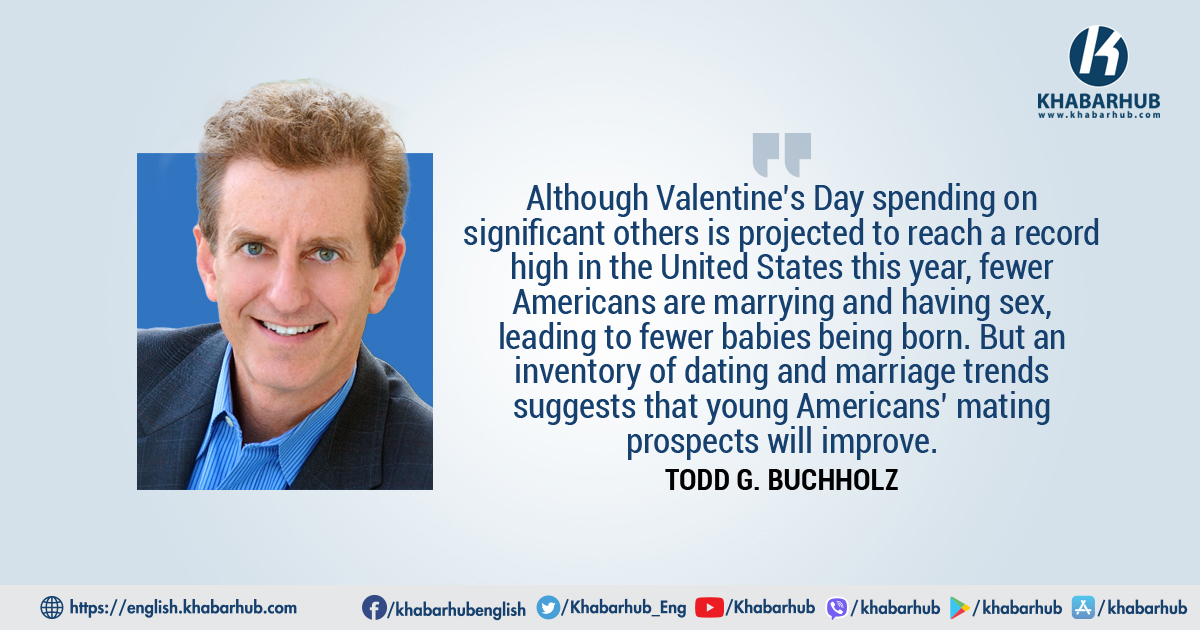0%

Cupid may be hitting the mark in the shopping aisle, but he’s not having much luck coaxing couples down the wedding aisle.
Although Valentine’s Day spending on significant others will reach a record high in the United States this year, fewer Americans are marrying and having sex, leading to fewer babies being born.
But there is evidence to suggest that Cupid’s aim will improve in coming years. If we want to survive as a species, we should be rooting for the pudgy cherub’s success.
It’s easy to point to all sorts of dreadful news about the prospects for young people globally.
A survey by Japan’s National Institute of Population and Social Security found that 17.3% of men and 14.6% of women aged between 18 and 34 have no intention of ever tying the knot, while many young women are swearing off sex altogether.
In the US, Generation Z tells pollsters that they will never earn enough money to buy a home, while 59% of young people around the world say they are very or extremely worried about the planet overheating.
Soaring inflation pushed up mortgage rates. But there are grounds for hope this year: ribbon-cutting ceremonies for multifamily buildings representing more than 700,000 new apartments are scheduled.
And yet a careful inventory of modern-day American dating and marriage trends gives hope that candlelight dinners for two are not a thing of the past. Let’s organize our inventory with the acrostic ROMANCE:
Rings are pricey, with the average engagement ring costing about $5,500.
But this average is biased upward by Kardashian wannabees, who stroll around with diamonds that could rival I.M. Pei’s pyramid at the Louvre.
One fascinating study revealed that couples who spend more on an engagement ring are more likely to get divorced.
Thankfully, the median cost of an engagement ring has been going down, perhaps because lab-grown diamonds offer the same sparkle as their mined counterparts at a fraction of the cost.
Moreover, many couples eschew new rings, preferring family heirlooms like great-grandma’s Art Deco bling from the Flapper era.
Online dating is fraught with sharks and frauds. And yet it opens the door to a world of opportunities for the more than half of Gen Zers and Millennials who use these apps daily.
In the “old days” in the “old country,” wherever that was, villagers relied on matchmakers and arranged marriages (some still do).
Even in the 1950s, the chance to marry someone from outside your county often depended on a college sojourn or an overseas vacation – options available only to the privileged.
Today, finding a mate online costs relatively little, and a careful “shopper” can curate by looks, education, and hobbies, rather than relying on introductions from Aunt Sylvia’s bridge partner.
Marriages are less common than in prior eras, and the age of a first-time married couple is climbing fast.
While Steve Carell’s titular character in the 2005 comedy The 40-Year-Old Virgin was an outlier to be laughed at, his plight seems more plausible today.
In 2021, 25% of 40-year-olds had never been married, compared to just 7% in 1960. But delaying marriage could make sense with rising life expectancy.
In 1960, the average 40-year-old American male could expect to live to 73, whereas a 40-year-old today will likely reach 85.
That still leaves many years of matrimonial bliss or bickering for those who postpone it.
Accommodations are pricey, with Zillow reporting that it takes nearly 12 years for a typical first-time US homebuyer to save for a down payment.
So where can a youngish couple live? The COVID-19 work-from-home craze spurred city-dwellers to buy up suburban abodes and landlords to raise rents.
Nearly a hundred years ago, Cole Porter wrote the song “Let’s Do It (Let’s Fall in Love),” observing that, “Birds do it, bees do it, even educated fleas do it.” Young people may be slow learners, but they’re likely to catch on.
Soaring inflation pushed up mortgage rates. But there are grounds for hope this year: ribbon-cutting ceremonies for multifamily buildings representing more than 700,000 new apartments are scheduled.
Moreover, several states have recently passed laws permitting homeowners to construct backyard cottages.
Nullifications and divorces are down, which suggests that couples who do marry like each other more. In fact, the divorce rate has been plunging since 1980, and recently reached a 50-year low.
Of course, that’s no guarantee of happiness. The great comedian Jack Benny said that in 50 years of marriage, he and his wife, Mary, never considered divorce. “Murder, yes, but divorce, never.”
Ceremonies can be more inventive. American newlyweds spend about $30,000 on feeding and entertaining their wedding guests.
No wonder 73% of young couples think it’s too expensive to marry! (Their parents might agree.)
While few will choose an old-fashioned party in the church gymnasium under banners proclaiming, “Go Hoosiers,” many are seeking more frugal celebrations on family patios and in back gardens.
Eros is the Greek name for Cupid, and he’s puzzled by the discipline of young people.
Compared to their parent’s generation, they drink less alcohol, go to bed earlier, and more frequently go to bed alone.
The share of 18 to 35-year-olds who did not have sex in the past year has doubled since 1990.
Does this trend come from a rise in religion, a fear of rashes, or just a desire to stay at home playing video games?
Regardless, when these unsexed singles finally meet the right mate, more than fireworks could explode.
Nearly a hundred years ago, Cole Porter wrote the song “Let’s Do It (Let’s Fall in Love),” observing that, “Birds do it, bees do it, even educated fleas do it.” Young people may be slow learners, but they’re likely to catch on.
(Todd G. Buchholz is a former White House director of economic policy under President George W. Bush)
Copyright: Project Syndicate